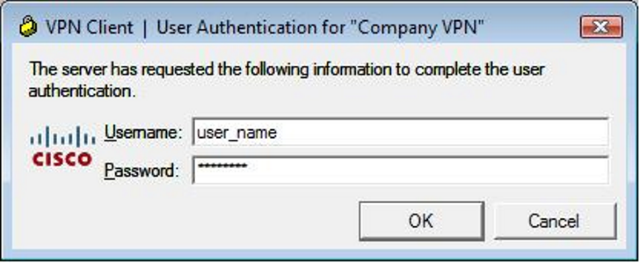

- Vpn client install#
- Vpn client windows 10#
- Vpn client software#
- Vpn client password#
- Vpn client free#
WatchGuard also supports the NCP client ( ) for connections to WatchGuard devices. For detailed instructions written for WatchGuard IPSec Mobile VPN Client end-users, see End-User Instructions for IPSec Mobile VPN Client Installation.
Vpn client install#
To use the client after the initial 30 day trial period, you must purchase a WatchGuard IPSec Mobile VPN Client license.įor installation instructions, see Install the IPSec Mobile VPN Client Software.
Vpn client free#
The IPSec Mobile VPN Client includes a free 30-day trial license.

This VPN client, powered by NCP, is compatible with all versions of Fireware, and supports all WatchGuard Mobile VPN with IPSec configuration settings.
Vpn client software#
You can download the WatchGuard IPSec Mobile VPN client from the Software Downloads section of the WatchGuard website. It enables you to provide remote access to your internal networks and not compromise your security. The Mobile VPN client creates an encrypted tunnel to your trusted and optional networks, which are protected by a Firebox. The user connects with a standard Internet connection and activates the Mobile VPN client to get access to protected network resources. To see if you’re connected to the VPN while you’re doing things on your PC, select the Network icon (either or ) on the far right of the taskbar, then see if the VPN connection says Connected.The WatchGuard IPSec Mobile VPN Client is installed on a mobile client computer, whether the user travels or works from home. When connected, the VPN connection name will display Connected underneath it. If the VPN section in Settings opens, select the VPN connection there, then select Connect. If the Connect button displays under the VPN connection, select Connect. Select the VPN connection you want to use, then do either of the following depending on what happens when you select the VPN connection: On the far right of the taskbar, select the Network icon (either or ). In the Server name or address box, enter the address for the VPN server. This is the VPN connection name you'll look for when connecting. In the Connection name box, enter a name you'll recognize (for example, My Personal VPN). Select the Start button, then select Settings > Network & Internet > VPN > Add a VPN connection. A VPN connection can help provide a more secure connection and access to your company's network and the internet, for example, when you’re working from a coffee shop or similar public place.
Vpn client windows 10#
Whether it's for work or personal use, you can connect to a virtual private network (VPN) on your Windows 10 PC. To see if you’re connected to the VPN while you’re doing things on your PC, hover your mouse pointer over the Network icon on the far right of the taskbar, then see if the VPN connection shows. When connected, the VPN connection name will display Connected underneath it.
Vpn client password#
If you're prompted, enter your username and password or other sign-in info. Next to the VPN connection you want to use, select Connect. In Settings, select Network & internet > VPN. When you have a VPN profile, you’re ready to connect. If you need to edit the VPN connection info or specify additional settings, such as proxy settings, choose the VPN connection and then select Advanced options. Enter your username and password in the respective boxes (if required). This might be a username and password, one-time password, certificate, or a smart card if you’re connecting to a VPN for work. You’ll need to know which kind of VPN connection your company or VPN service uses.įor Type of sign-in info, choose the type of sign-in info (or credentials) to use. In the Server name or address box, enter the address for the VPN server.įor VPN type, choose the type of VPN connection you want to create. In the Connection name box, enter a name you'll recognize (for example, My Personal VPN). In Add a VPN connection, do the following:įor VPN provider, choose Windows (built-in). Select Settings > Network & internet > VPN > Add VPN. Select the Start button, then type settings. If it’s for a VPN service you subscribe to for personal use, visit the Microsoft Store to see if there’s an app for that service, then go to the VPN service’s website to see if the VPN connection settings to use are listed there. If it’s for work, look for VPN settings or a VPN app on your company’s intranet site while you’re at work, or contact your company's support person.

You can either create a VPN profile on your own or set up a work account to get a VPN profile from your company. Learn more Create a VPN profileīefore you can connect to a VPN, you must have a VPN profile on your PC. This feature is not available in Windows 11 SE.


 0 kommentar(er)
0 kommentar(er)
